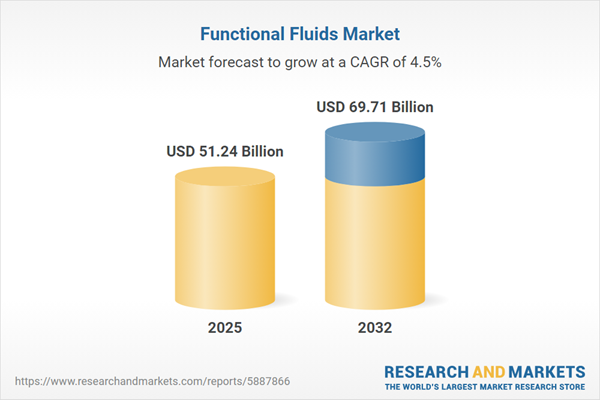Speak directly to the analyst to clarify any post sales queries you may have.
The functional fluids market is critical for uninterrupted industrial workflows and optimized sourcing strategies in high-stakes sectors. Senior decision-makers depend on sophisticated fluid management to ensure efficiency, manage regulatory compliance, and support equipment reliability.
Market Snapshot: Functional Fluids Market Size and Growth
The global functional fluids market is registering steady growth, driven by continuing industrialization and shifts in compliance regulations across regions. According to recent industry analysis, the market is set for consistent expansion through 2032, backed by sustained manufacturing momentum and targeted investments in transportation infrastructure. Industrial and transport operators pursue operational stability and increasingly deploy advanced fluid technologies to protect workflow continuity. Continual innovation in functional fluids boosts equipment performance and asset durability. As regulatory demands intensify, investment in comprehensive fluid management is now indispensable for addressing strategic reliability and risk mitigation needs.
Scope & Segmentation of the Functional Fluids Market
This report provides focused insight for leaders tasked with selecting, sourcing, and implementing functional fluids solutions in alignment with enterprise objectives. Our segmentation offers actionable intelligence for identifying procurement levers, performance differentiators, and industry adoption trends:
- Fluid Types: Compressor oils, engine oils, gear oils, heat transfer fluids, hydraulic fluids, metalworking fluids, process oils, refrigeration oils, and turbine fluids support diverse challenges in uptime and performance management.
- Additive Types: Anti-wear agents, antifoam agents, antioxidants, corrosion inhibitors, detergents, friction modifiers, and pour point depressants are essential for extending equipment use and reducing downtime.
- Applications: Aerospace, automotive, chemical processing, food and beverage, industrial machinery, marine, mining, and power generation sectors each pose distinctive maintenance and regulatory requirements, necessitating tailored fluid solutions.
- Geographies: Americas, Europe, Middle East, Africa, and Asia-Pacific are the principal regions, with procurement landscapes shaped by market drivers in the United States, Canada, Germany, China, India, and South Africa. Each geography introduces unique risk considerations and supplier engagement strategies.
- Industry Players Profiled: Exxon Mobil Corporation, Royal Dutch Shell plc, The Dow Chemical Company, BASF SE, Chevron Phillips Chemical Company LLC, Solvay S.A., Clariant AG, Evonik Industries AG, Eastman Chemical Company, and Huntsman Corporation are analyzed for supplier strategy and market presence amid shifting regulatory and operating frameworks.
Key Takeaways for Senior Decision-Makers
- Implementing digital monitoring and connected IoT solutions enhances visibility across fluid systems, which enables predictive maintenance and reduces unplanned outages in continuous production environments.
- Heightened environmental standards are accelerating adoption of bio-based and environmentally responsible fluids, driving procurement teams to anticipate sector-specific sustainability and compliance requirements.
- Ongoing technological advances in additive formulations bolster equipment resilience for machinery exposed to variable workload and operational stresses, minimizing risks related to wear and performance deterioration.
- Adaptive procurement strategies remain vital for aligning operations with shifting compliance guidelines and evolving operational needs, equipping organizations to manage both planned adjustments and unexpected disruptions.
- Engaging with regional and local suppliers strengthens supply chain reliability, positioning businesses for prompt response to market volatility or changes in the regulatory environment across jurisdictions.
Tariff Impact: Navigating Trade and Sourcing Dynamics
Recent U.S. chemical import tariffs compel procurement leaders to reassess sourcing models in the functional fluids market. A decisive shift is emerging toward regional and domestic manufacturing partnerships that deliver improved cost management and bolster risk mitigation against unpredictable tariff environments. These nimble strategies enhance business continuity and reduce exposure to trade-related volatility, providing greater strategic agility to sector leaders.
Methodology & Data Sources
This analysis integrates direct interviews with manufacturers, formulators, and end-users to offer a robust executive lens on the market. Additional insights draw from technical literature, regulatory developments, and financial documents, ensuring a comprehensive understanding of procurement preferences and compliance strategies as market conditions evolve.
Why This Report Matters
- Supports executive leadership in managing complex regulatory and sustainability requirements using rigorous market intelligence for functional fluids.
- Strengthens risk management and procurement planning with forward-looking insights tailored to dynamic industrial environments.
- Equips organizations to mitigate operational and supply chain risk by developing resilient, adaptive sourcing frameworks in response to rapid market changes.
Conclusion
Emphasizing advanced fluid management practices and fostering robust supplier relationships positions organizations to protect reliability and sustain performance as industrial and compliance demands shift.
Additional Product Information:
- Purchase of this report includes 1 year online access with quarterly updates.
- This report can be updated on request. Please contact our Customer Experience team using the Ask a Question widget on our website.
Table of Contents
3. Executive Summary
4. Market Overview
7. Cumulative Impact of Artificial Intelligence 2025
Companies Mentioned
The companies profiled in this Functional Fluids market report include:- Exxon Mobil Corporation
- Royal Dutch Shell PLC
- The Dow Chemical Company
- BASF SE
- Chevron Phillips Chemical Company LLC
- Solvay S.A.
- Clariant AG
- Evonik Industries AG
- Eastman Chemical Company
- Huntsman Corporation
Table Information
| Report Attribute | Details |
|---|---|
| No. of Pages | 195 |
| Published | November 2025 |
| Forecast Period | 2025 - 2032 |
| Estimated Market Value ( USD | $ 51.24 Billion |
| Forecasted Market Value ( USD | $ 69.71 Billion |
| Compound Annual Growth Rate | 4.5% |
| Regions Covered | Global |
| No. of Companies Mentioned | 11 |









